Situated at the mouth of the River Wyre, Fleetwood was founded in 1830 by Sir Peter Hesketh. The oldest part of the town is centred around The Mount, which is the last of a long line of sand hills. The streets of the town work out from this epicentre in a spider’s web type formation.
Up until the 1970’s Fleetwood was one of the UK’s most prominent fishing ports, but beginning with the Icelandic cod wars in the 1960’s, then fishing quota cut backs through the 80’s and 90’s, the port now has just a small handful of working fishing vessels left.
The town has made its mark in the world in other ways too. In 1885 Fleetwood had an electrified tramway with trams running along the main street which was the first of its kind in Britain. And in 1922 the town was the first to install an automatic telephone exchange.
Fleetwood also sports no less than three lighthouses. The Lower and Upper lighthouses are situated inside the town. The town lighthouses are lined up to indicate safe passage through the shipping channel. The Wyre Light is the only seaward one positioned at the northward end of the very shallow North Wharf sandbank which stretches all the way out to the famous Lune Deeps in Morecambe Bay which drops down to 220-feet at its deepest point.
Our host for the day, Andy Bradbury, skipper of the “Blue Mink” is well known in small boat fishing circles having been secretary of the famous Fylde Small Boats club for 10 years and a regular small boat angler since the age of 16. He’s been working his 31 ft Mitchell out from Fleetwood for the past four years building up a reputation for consistent catches throughout the year.
If you book an 8-hour trip with Andy he picks you up off the beach by the Life Boat station, but on 10 and 12-hour trips pick up is from the nearby marina.
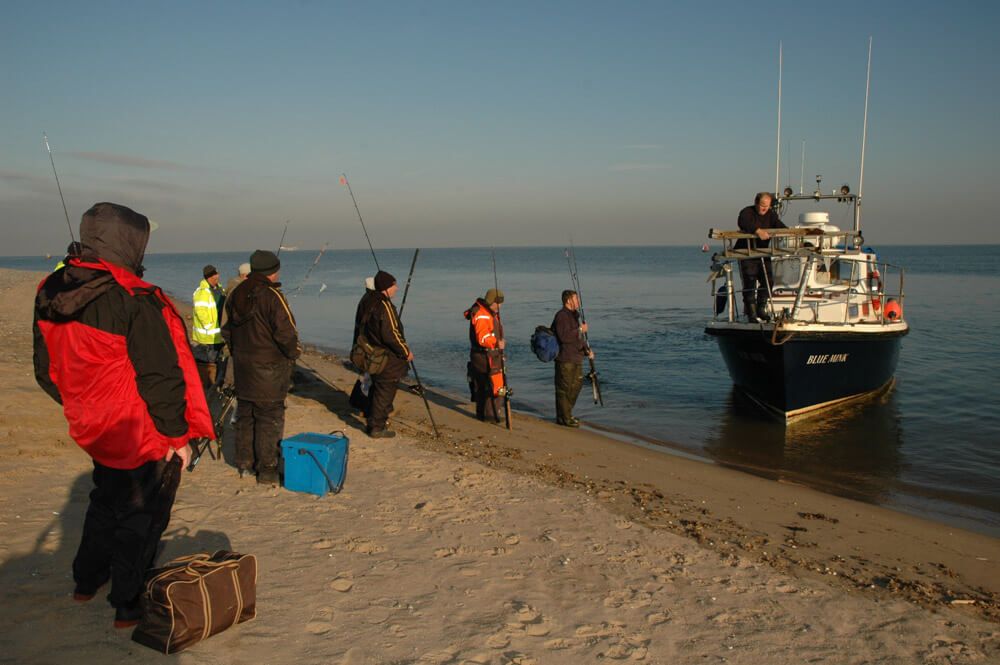
“Blue Mink” also has a British record dogfish weighing 4lbs 9ozs to her credit taken by Mark Donnelly from Preston on a lug and squid cocktail.
RIGS, BAITS & TACTICS
Simple rigs work the best here. For general uptide fishing a simple flowing ledger rig keeping the bait hard on the seabed is ideal for the cod, rays and smoothhound, with the fish coming up against the weight of the lead as they turn in to the tide to promote self-hooking. On the day, the lad’s uptiding were also incorporating sliding booms in to their rigs to minimise the tangles. Hook sizes should be 2/0 to 4/0 Partridge Uptide Sting Points or Mustad Vikings.
For smaller species use a longer sliding boom with a flowing trace around 40-inches long carrying three size 1 Aberdeen’s hooks at spaced intervals. This is a great rig for the dabs, whiting, gurnards and small codling.
Andy has his own favourite flowing trace rig which sports a 40-inch length of 50lb clear mono with a small blood loop tied towards the top, and at the end of the 50lb mono he uses a leader knot to add a short 12-inch section of 25lb mono. The addition of the 25lb mono gives a little more movement to the bait when fishing, but also works as a weak link should the hook get snagged when fishing over rougher ground.
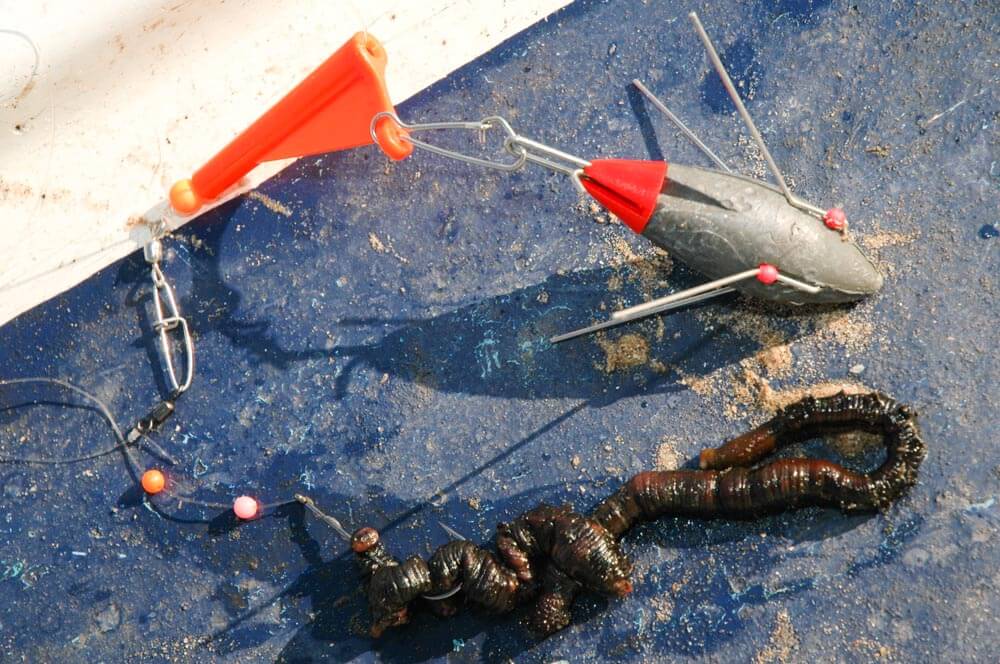
In the summer always add brightly coloured beads above the hooks when plaice fishing. There seems to be no specific colour combinations regards beads here, but the plaice are caught in just 6 to 12-feet of water, so the key is to fish fine. Fluoro carbon hook lengths around 12lbs breaking strain will give you an edge here. The beads can also work well on the codling too.
The key bait here is black lug, fresh is best but frozen black more than holds its own and can occasionally out fish the fresh when really “sticky”. Tipping black with a couple of fresh blow lug can also increase the catch on the day. Andy uses one of the top local diggers and can get fresh worm to order for those who want it.
Talking to both Skipper Andy and the regular anglers aboard, some carry squid and add this as a strip below the lug, but they say it catches too many dogfish at times and plain lug is the best all round bait. Mackerel is also useful in winter, but again can pull in the doggies, though mackerel is a good summer boat for many species as you’d expect.
Other baits that work are mussel and razorfish, but ragworm is said to be a poor bait locally. Peeler crab is good for the early season bass, but then you should switch to sandeel or artificials as summer proper arrives.
Andy enjoys a bumper tope run here too, so you’ll need 200lb mono traces, or 60lb mono traces with 15-inches of 50lb wire at the end for these, fished as a flowing trace below and sliding ledger. Top hook is a Viking 6/0 or Partridge Uptide Sting Point 6/0, but crimp the barb down before fishing.
During the neap tides you can comfortably fish mono as the water depth generally is not that deep. However, on the spring tides, the tide run can touch over 2-knots, so braid is a useful option to have and minimises the amount of lead you’ll need to hold bottom.
Carry leads up to 12ozs for general fishing, but mostly 6 to 8ozs will cope.
There are wrecks to fish too, though these tend to be a fair way off. Out here a 30lb class rod and reel with braid is the best choice. Leads up to a pound or more may be needed though.
When fishing off the stern, you can deliberately choose a flat or round lead just heavy enough to hold bottom, but by lifting the weight occasionally you can bounce a bait further down tide. This can pick up extra fish, especially gurnards and plaice, which like a bait on the move.
IN SESSION
The dawn dawned fine, clear and still with a good overnight frost making the anglers wrap up warm. We were picked up off the beach and headed straight out to a mark called “The Sausage” off Anchorsholme. Not surprisingly this mark is the shape of a sausage and was mixed rough ground likely to hold codling.
Immediately the lads started catching a few doggies just to get warmed up, then the whiting arrived to keep everyone busy.
Andy mentioned that so far the codling, due to the warmer than usual for the time of year water temperatures, were still a little slow to show. However he had been picking them up steadily averaging just a couple of pounds or so, but with the odd better fish over 3lbs amongst them.
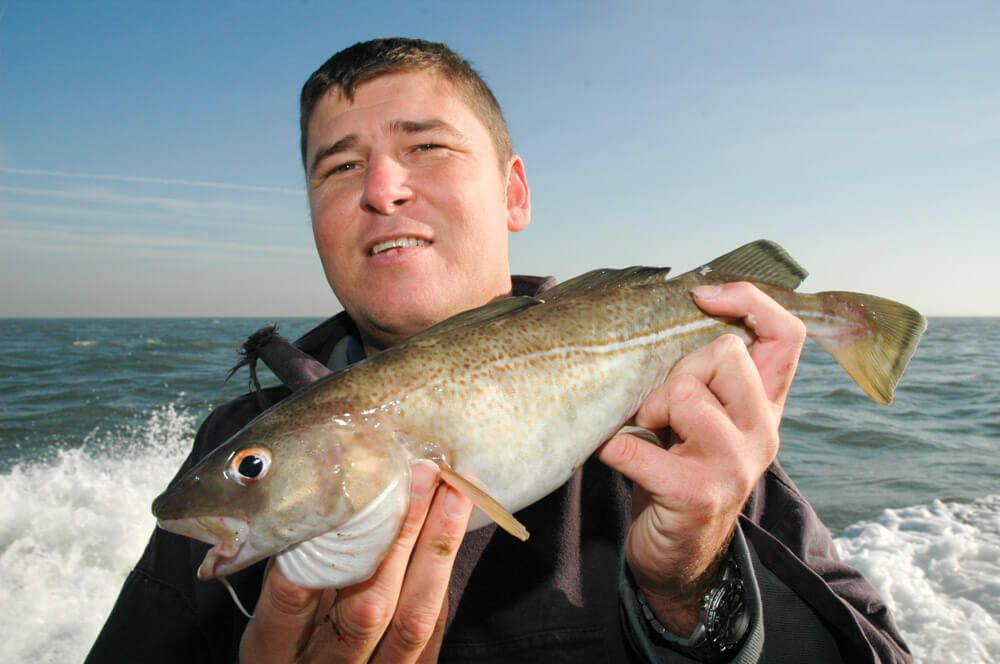
Sure enough and right on cue, local rod Rick from nearby Bispham stood on the port quarter, picked up the first codling on a plain lug bait. A steady stream of whiting, dogs, pout and poor cod were coming aboard, as well as the odd codling, but Andy wasn’t too happy with the way the mark was shaping up, so after a couple of hours chose to switch marks as the tide was heading towards low slack.
Anchoring up over a mark called “Patches” the ground seemed to be exactly that, patches of clean ground mixed in with a little rough.
Again this area started to produce whiting, poor cod and pout, but this time dabs were amongst them. Andy mentioned that he expected the cod to start to show as it neared low water and sure enough the codling came on the feed as the tide eased off.
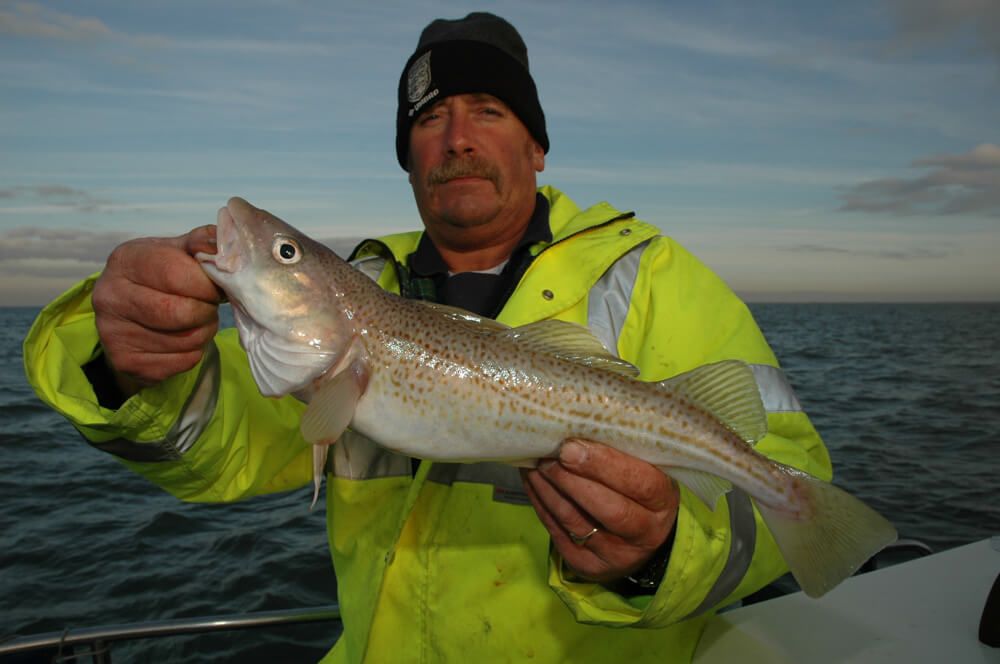
Again these were codling in the 1.5lbs to 2lbs bracket, but in fair numbers and plump fish with an eagerness to feed.
There were a few big edible red crab picking up the baits too, so a bonus supper is always on the cards here.
This mark was also said to produce the odd huss, and Preston angler John Pictall was uptiding using a lug and squid cocktail when he had a different heavier bite that pulled the lead out with the fish hammering off down tide. A good scrap ensued and superbly spotted double figure huss was lifted aboard. In season Andy says he regularly gets huss in excess of 14lbs, so it’s one to remember if you want to sit it out with a whole squid or medium sized mackerel flapper bait.
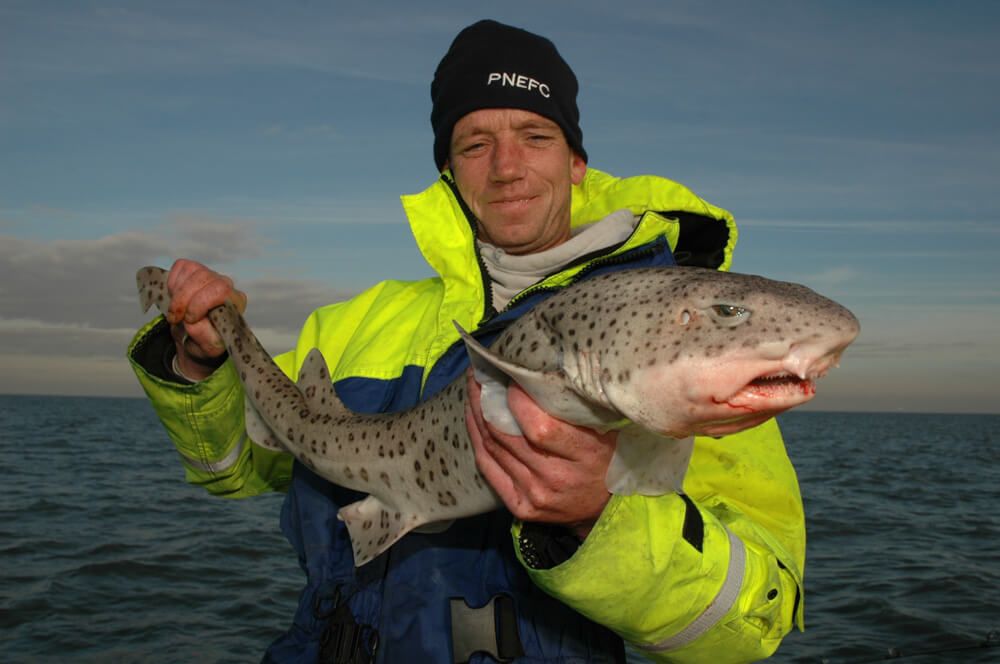
The day eased in to darkness and with the first of the flood came more dabs, whiting, codling, another smaller huss, plus poor cod and pout. Everyone aboard had codling and enjoyed an early winters day fishing.
It was happy short steam home in the pitch dark with several of the lads on board that day being regulars aboard “Blue Mink” and they were already looking forward to another trip a few days later.
SEASONS
The season starts in March and April with the plaice and Andy said the plaice fishing during 2006 was the best seen off Fleetwood in the last 20-years. The same period sees thornback rays, though the rays have become a year round thing here of late and a 16lber was a recent catch.
Both starry and common smoothhound appear in May along with the bass, followed by the tope which run in numbers from early June to late July with odd fish outside this period. The boats best tope was a fine 58lber. There’s also some good summer cod caught off the Barrow marks too. Mackerel appear in May and leave October time, so summer bait is usually easy to get.
We’re not giving anything away as its common knowledge, but the bass fishing on artificial shads around No 2 Heysham Buoy can be excellent with fish in to double figures taken every summer, and more and more anglers here are booking bass days with Andy, who also has reef bass marks too.
The ground also carries some big tub gurnards to 7lbs, ling, conger, and a host more species. Andy says most anglers now fish for species and he has a book that lists no less than 37 species taken aboard “Blue Mink” in the past four seasons. Black bream are also showing in increasing numbers during the summer and he’s looking to get his first trigger fish aboard in the next season or two.
The whiting build in numbers from September, but the cod season is definitely getting later and it’s usually October nowadays before it kicks in to action with numbers peaking around Christmas. The bigger fish show in January to mid February, with a 20lber always on the cards from these Morcambe Bay marks.
SKIPPERS TOP TIPS
Andy’s advice is to always fish as light as is sensible to maximise both sport and bite detection. He recommends you carry a 12 to 15lb class rod for general fishing, and a 20lb class or 4-8oz uptider for heavier fishing. That’s pretty much all you need. A 30lb rod is useful and will cover you for the deeper water, wrecks and rougher ground if needed.
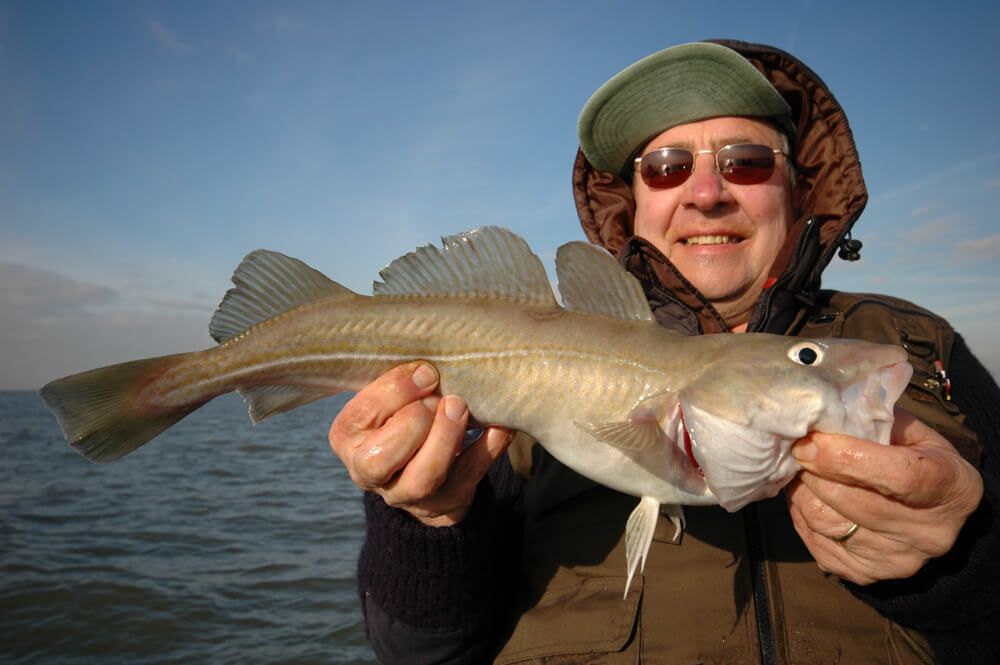
Even on neap tides he can find marks that carry some tide run, so he favours a flowing trace over other rigs to give good movement to the baits, though suggests you also carry a few rigs using a boom for the times when the tide is slack to give better presentation.
Another tip is not to skimp on bait size when after the cod. Use big baits up to 6-inches long and change your baits every 15 minutes or so. This is to maximise the scent lane for the fish to follow.
VERDICT
There are few ports which can offer the full variety of fish that Fleetwood can, plus it has excellent winter fishing and by the looks of it building codling numbers which looks good for the future. That’s why species anglers are making a bee line for Fleetwood.
Another major advantage with the port is that the marks you’ll be fishing are all relatively close in and within a short steaming time, bar for the wrecks.
Getting to Fleetwood is also easy as you leave the M6, follow the M55, then it’s the A585 leading right on to the seafront with free parking by the Life Boat pick up point. Peace of cake!
The other big factor is Andy’s own background. Being an experienced small boat angler means he thinks about the fishing and adjusts his boat position and tactics accordingly to maximise catches. You’re in very good hands!
CHARTER BOATS
“Blue Mink” Skipper – Andy Bradbury Tel: 01253 354567
Up until the 1970’s Fleetwood was one of the UK’s most prominent fishing ports, but beginning with the Icelandic cod wars in the 1960’s, then fishing quota cut backs through the 80’s and 90’s, the port now has just a small handful of working fishing vessels left.
The town has made its mark in the world in other ways too. In 1885 Fleetwood had an electrified tramway with trams running along the main street which was the first of its kind in Britain. And in 1922 the town was the first to install an automatic telephone exchange.
Fleetwood also sports no less than three lighthouses. The Lower and Upper lighthouses are situated inside the town. The town lighthouses are lined up to indicate safe passage through the shipping channel. The Wyre Light is the only seaward one positioned at the northward end of the very shallow North Wharf sandbank which stretches all the way out to the famous Lune Deeps in Morecambe Bay which drops down to 220-feet at its deepest point.
Our host for the day, Andy Bradbury, skipper of the “Blue Mink” is well known in small boat fishing circles having been secretary of the famous Fylde Small Boats club for 10 years and a regular small boat angler since the age of 16. He’s been working his 31 ft Mitchell out from Fleetwood for the past four years building up a reputation for consistent catches throughout the year.
If you book an 8-hour trip with Andy he picks you up off the beach by the Life Boat station, but on 10 and 12-hour trips pick up is from the nearby marina.

“Blue Mink” also has a British record dogfish weighing 4lbs 9ozs to her credit taken by Mark Donnelly from Preston on a lug and squid cocktail.
RIGS, BAITS & TACTICS
Simple rigs work the best here. For general uptide fishing a simple flowing ledger rig keeping the bait hard on the seabed is ideal for the cod, rays and smoothhound, with the fish coming up against the weight of the lead as they turn in to the tide to promote self-hooking. On the day, the lad’s uptiding were also incorporating sliding booms in to their rigs to minimise the tangles. Hook sizes should be 2/0 to 4/0 Partridge Uptide Sting Points or Mustad Vikings.
For smaller species use a longer sliding boom with a flowing trace around 40-inches long carrying three size 1 Aberdeen’s hooks at spaced intervals. This is a great rig for the dabs, whiting, gurnards and small codling.
Andy has his own favourite flowing trace rig which sports a 40-inch length of 50lb clear mono with a small blood loop tied towards the top, and at the end of the 50lb mono he uses a leader knot to add a short 12-inch section of 25lb mono. The addition of the 25lb mono gives a little more movement to the bait when fishing, but also works as a weak link should the hook get snagged when fishing over rougher ground.

In the summer always add brightly coloured beads above the hooks when plaice fishing. There seems to be no specific colour combinations regards beads here, but the plaice are caught in just 6 to 12-feet of water, so the key is to fish fine. Fluoro carbon hook lengths around 12lbs breaking strain will give you an edge here. The beads can also work well on the codling too.
The key bait here is black lug, fresh is best but frozen black more than holds its own and can occasionally out fish the fresh when really “sticky”. Tipping black with a couple of fresh blow lug can also increase the catch on the day. Andy uses one of the top local diggers and can get fresh worm to order for those who want it.
Talking to both Skipper Andy and the regular anglers aboard, some carry squid and add this as a strip below the lug, but they say it catches too many dogfish at times and plain lug is the best all round bait. Mackerel is also useful in winter, but again can pull in the doggies, though mackerel is a good summer boat for many species as you’d expect.
Other baits that work are mussel and razorfish, but ragworm is said to be a poor bait locally. Peeler crab is good for the early season bass, but then you should switch to sandeel or artificials as summer proper arrives.
Andy enjoys a bumper tope run here too, so you’ll need 200lb mono traces, or 60lb mono traces with 15-inches of 50lb wire at the end for these, fished as a flowing trace below and sliding ledger. Top hook is a Viking 6/0 or Partridge Uptide Sting Point 6/0, but crimp the barb down before fishing.
During the neap tides you can comfortably fish mono as the water depth generally is not that deep. However, on the spring tides, the tide run can touch over 2-knots, so braid is a useful option to have and minimises the amount of lead you’ll need to hold bottom.
Carry leads up to 12ozs for general fishing, but mostly 6 to 8ozs will cope.
There are wrecks to fish too, though these tend to be a fair way off. Out here a 30lb class rod and reel with braid is the best choice. Leads up to a pound or more may be needed though.
When fishing off the stern, you can deliberately choose a flat or round lead just heavy enough to hold bottom, but by lifting the weight occasionally you can bounce a bait further down tide. This can pick up extra fish, especially gurnards and plaice, which like a bait on the move.
IN SESSION
The dawn dawned fine, clear and still with a good overnight frost making the anglers wrap up warm. We were picked up off the beach and headed straight out to a mark called “The Sausage” off Anchorsholme. Not surprisingly this mark is the shape of a sausage and was mixed rough ground likely to hold codling.
Immediately the lads started catching a few doggies just to get warmed up, then the whiting arrived to keep everyone busy.
Andy mentioned that so far the codling, due to the warmer than usual for the time of year water temperatures, were still a little slow to show. However he had been picking them up steadily averaging just a couple of pounds or so, but with the odd better fish over 3lbs amongst them.

Sure enough and right on cue, local rod Rick from nearby Bispham stood on the port quarter, picked up the first codling on a plain lug bait. A steady stream of whiting, dogs, pout and poor cod were coming aboard, as well as the odd codling, but Andy wasn’t too happy with the way the mark was shaping up, so after a couple of hours chose to switch marks as the tide was heading towards low slack.
Anchoring up over a mark called “Patches” the ground seemed to be exactly that, patches of clean ground mixed in with a little rough.
Again this area started to produce whiting, poor cod and pout, but this time dabs were amongst them. Andy mentioned that he expected the cod to start to show as it neared low water and sure enough the codling came on the feed as the tide eased off.

Again these were codling in the 1.5lbs to 2lbs bracket, but in fair numbers and plump fish with an eagerness to feed.
There were a few big edible red crab picking up the baits too, so a bonus supper is always on the cards here.
This mark was also said to produce the odd huss, and Preston angler John Pictall was uptiding using a lug and squid cocktail when he had a different heavier bite that pulled the lead out with the fish hammering off down tide. A good scrap ensued and superbly spotted double figure huss was lifted aboard. In season Andy says he regularly gets huss in excess of 14lbs, so it’s one to remember if you want to sit it out with a whole squid or medium sized mackerel flapper bait.

The day eased in to darkness and with the first of the flood came more dabs, whiting, codling, another smaller huss, plus poor cod and pout. Everyone aboard had codling and enjoyed an early winters day fishing.
It was happy short steam home in the pitch dark with several of the lads on board that day being regulars aboard “Blue Mink” and they were already looking forward to another trip a few days later.
SEASONS
The season starts in March and April with the plaice and Andy said the plaice fishing during 2006 was the best seen off Fleetwood in the last 20-years. The same period sees thornback rays, though the rays have become a year round thing here of late and a 16lber was a recent catch.
Both starry and common smoothhound appear in May along with the bass, followed by the tope which run in numbers from early June to late July with odd fish outside this period. The boats best tope was a fine 58lber. There’s also some good summer cod caught off the Barrow marks too. Mackerel appear in May and leave October time, so summer bait is usually easy to get.
We’re not giving anything away as its common knowledge, but the bass fishing on artificial shads around No 2 Heysham Buoy can be excellent with fish in to double figures taken every summer, and more and more anglers here are booking bass days with Andy, who also has reef bass marks too.
The ground also carries some big tub gurnards to 7lbs, ling, conger, and a host more species. Andy says most anglers now fish for species and he has a book that lists no less than 37 species taken aboard “Blue Mink” in the past four seasons. Black bream are also showing in increasing numbers during the summer and he’s looking to get his first trigger fish aboard in the next season or two.
The whiting build in numbers from September, but the cod season is definitely getting later and it’s usually October nowadays before it kicks in to action with numbers peaking around Christmas. The bigger fish show in January to mid February, with a 20lber always on the cards from these Morcambe Bay marks.
SKIPPERS TOP TIPS
Andy’s advice is to always fish as light as is sensible to maximise both sport and bite detection. He recommends you carry a 12 to 15lb class rod for general fishing, and a 20lb class or 4-8oz uptider for heavier fishing. That’s pretty much all you need. A 30lb rod is useful and will cover you for the deeper water, wrecks and rougher ground if needed.

Even on neap tides he can find marks that carry some tide run, so he favours a flowing trace over other rigs to give good movement to the baits, though suggests you also carry a few rigs using a boom for the times when the tide is slack to give better presentation.
Another tip is not to skimp on bait size when after the cod. Use big baits up to 6-inches long and change your baits every 15 minutes or so. This is to maximise the scent lane for the fish to follow.
VERDICT
There are few ports which can offer the full variety of fish that Fleetwood can, plus it has excellent winter fishing and by the looks of it building codling numbers which looks good for the future. That’s why species anglers are making a bee line for Fleetwood.
Another major advantage with the port is that the marks you’ll be fishing are all relatively close in and within a short steaming time, bar for the wrecks.
Getting to Fleetwood is also easy as you leave the M6, follow the M55, then it’s the A585 leading right on to the seafront with free parking by the Life Boat pick up point. Peace of cake!
The other big factor is Andy’s own background. Being an experienced small boat angler means he thinks about the fishing and adjusts his boat position and tactics accordingly to maximise catches. You’re in very good hands!
CHARTER BOATS
“Blue Mink” Skipper – Andy Bradbury Tel: 01253 354567

